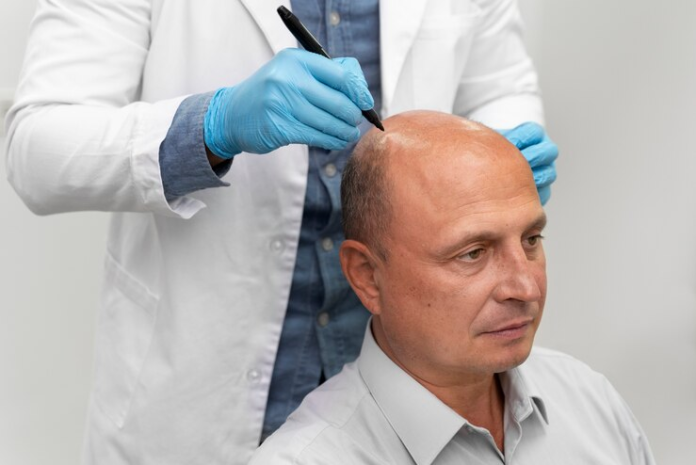A Hair Transplant is one of the most trusted and refined procedures for addressing hair loss and restoring natural hairlines. This advanced surgical technique involves extracting hair follicles from a donor area, typically the back or sides of the scalp, and carefully implanting them into areas affected by baldness or thinning hair. Over the years, the process has evolved with precision and artistry, giving individuals the confidence to reclaim a fuller head of hair. While many factors contribute to the overall treatment, understanding the detailed stages of a hair transplant ensures patients are well-informed and prepared before committing to the journey. If you’re curious about restoring your hair, knowing the stages of treatment is just as important as being aware of the Hair Transplant Cost in Dubai.
Stage 1: Initial Consultation and Evaluation
The very first step in the hair transplant process is a comprehensive consultation with an experienced surgeon. During this session, the doctor assesses the patient’s scalp, hair density, hair loss pattern, and overall scalp health.
The specialist will discuss your medical history, lifestyle, and expectations to determine if you are a suitable candidate for the procedure. Advanced diagnostic tools such as scalp analysis systems may be used to evaluate hair follicle strength and donor area condition. This ensures personalized treatment planning and realistic outcome forecasting.

Stage 2: Designing the Hairline and Treatment Plan
Once suitability is confirmed, the next step involves the design and mapping of the new hairline. This crucial stage combines medical precision with aesthetic judgment, ensuring the restored hairline complements the patient’s facial structure, age, and natural hair growth direction.
The surgeon carefully marks the recipient area and outlines the hairline design, taking into account hair density goals, future hair loss, and symmetry. The doctor also determines the total number of grafts required for optimal coverage and the exact donor regions for extraction.
Stage 3: Preparation of Donor and Recipient Areas
On the day of the surgery, both the donor and recipient areas are cleaned and sterilized to minimize infection risks. Local anesthesia is administered to numb these areas, ensuring a painless and comfortable experience throughout the procedure.
The donor area, typically the back of the head, is trimmed to make follicle extraction easier and to obtain high-quality grafts. Similarly, the recipient area is prepared by making tiny incisions or channels, which will later house the extracted hair follicles.
Stage 4: Extraction of Hair Follicles
This critical phase involves the harvesting of hair follicles from the donor area. Depending on the technique chosen — either FUT (Follicular Unit Transplantation) or FUE (Follicular Unit Extraction) — the process differs slightly:
- FUT Method: A narrow strip of scalp is surgically removed from the donor region. This strip is then dissected under a microscope to separate individual follicular units.
- FUE Method: Individual hair follicles are directly extracted from the donor area using a specialized micro-punch device. This technique is minimally invasive and leaves tiny dot-like scars.
The extracted follicles are immediately preserved in a special solution to maintain their vitality until implantation.
Stage 5: Implantation of Hair Follicles
Following extraction, the hair follicles are carefully implanted into the pre-made incisions in the recipient area. The surgeon meticulously places each follicle at a precise angle and direction to mimic the natural hair growth pattern.
This stage requires artistic skill and technical expertise, as the density, distribution, and orientation of the implanted follicles determine the final aesthetic outcome. The number of grafts transplanted depends on the degree of baldness and the patient’s desired coverage.
Stage 6: Post-Operative Care and Monitoring
After completing the implantation, the doctor will clean the treated areas and apply a protective dressing or bandage if necessary. Patients receive detailed instructions on how to care for the scalp during the initial healing phase.
The surgeon schedules follow-up appointments to monitor the healing process, check for any complications, and ensure optimal graft survival. The doctor will also guide patients on when to resume regular activities, including washing hair and light exercise.
Stage 7: Hair Growth Progression and Results
Hair growth following a transplant is a gradual process. In the initial weeks, implanted hair may shed naturally — a normal part of the hair growth cycle known as “shock loss.” New hair begins to grow within three to four months after the procedure.
Patients typically witness significant visible improvements between six to nine months, with the final, fully matured results appearing within twelve to eighteen months. Throughout this period, the surgeon schedules routine evaluations to track growth progress and address any concerns.
Benefits of Knowing the Hair Transplant Stages
Understanding the individual stages of a hair transplant offers several advantages:
- Informed Decision-Making: Patients can set realistic expectations by knowing what each stage entails.
- Better Preparation: Being aware of the procedural timeline allows individuals to plan time off work, travel, and recovery.
- Enhanced Confidence: Familiarity with the process reduces anxiety and builds trust between the patient and surgeon.
- Optimal Aftercare: Knowing post-operative guidelines ensures proper scalp care and maximizes graft survival.
- Appreciation of Natural Results: Recognizing the role of precise follicle placement and hairline design highlights the artistry involved in achieving natural-looking outcomes.
Final Thoughts
A hair transplant is a refined, medically advanced treatment that requires not only surgical skill but also an artistic eye to deliver natural, lasting results. Each stage — from consultation and hairline design to follicle extraction and post-operative care — plays a vital role in ensuring patient satisfaction and optimal hair restoration outcomes.
































